Weather Systems and Severe Weather
OUR ATMOSPHERE IS DYNAMIC, featuring various types of weather systems, some relatively benign and beneficial, while others, like hurricanes and tornadoes, are dangerous and destructive. What types of weather do we experience, what causes weather, and what determines if a weather system is relatively gentle or severe? In this chapter, we explore the main types […]

Water Resources
WATER IS ARGUABLY THE MOST IMPORTANT RESOURCE provided by Earth — all life on Earth needs water to live and thrive. We are most familiar with surface water, water that occurs in streams, lakes, and oceans. Yet, the amount of fresh water in these settings is much less than the amount of fresh water that […]

Who Polluted Surface Water and Groundwater in This Place?
SURFACE WATER AND GROUNDWATER in this area are contaminated. You will use the physical geography of the area, along with elevations of the water table and chemical analyses of the contaminated water, to determine where the contamination is, where it came from, and where it is going. From your conclusions, you will decide where to […]

What Is Happening with the Ogallala Aquifer?
THE MOST IMPORTANT AQUIFER IN THE U.S. lies beneath the High Plains, stretching from South Dakota to Texas. It provides groundwater for about 30% of all cropland in the country, but it is severely threatened by overpumping. The setting, characteristics, groundwater flow, and water-use patterns of this aquifer connect many different aspects of water resources […]

How Does Groundwater Contamination Move and How Do We Clean It Up?
WATER CONTAMINATION CAN BE OBVIOUS OR SUBTLE. Some streams and lakes have oily films and give off noxious fumes, but some contamination occurs in water that looks normal and tastes normal but contains hazardous amounts of a natural or human-related chemical component. How does contamination in groundwater move, how do we investigate its causes and […]
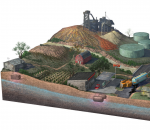
How Can Water Become Contaminated?
CONTAMINATION OF SURFACE- AND SUBSURFACE-WATER SUPPLIES is a major problem facing many communities. Some contaminants are natural products of the environment, whereas others have human sources, the direct result of our modern lifestyle. What are some main sources of water contamination? 1. Examine this figure, trying to recognize every potential source that could contaminate surface […]

What Problems Are Associated with Groundwater Pumping?
THE SUPPLY OF GROUNDWATER IS FINITE, so pumping too much groundwater, a practice called overpumping, can result in serious problems. Overpumping can cause neighboring wells to dry up, land to subside, and gaping fissures to open across the land surface. What Happens to the Water Table if Groundwater Is Overpumped? Demands on water resources increase […]

What Is the Relationship Between Surface Water and Groundwater?
SURFACE WATER AND GROUNDWATER ARE NOT ISOLATED SYSTEMS. Rather, they are highly in terconnected with water flowing from the surface to the subsurface and back again. Most groundwater forms from surface water that seeps into the ground, and some streams and lakes are fed by groundwater. How Does Water Move Between the Surface and Subsurface? […]

How and Where Does Groundwater Flow?
GROUNDWATER FLOWS BENEATH THE SURFACE in ways that are controlled by several key principles. The direction and rate of groundwater flow are largely controlled by the porous nature of the materials, the slope of the water table, and the geometry and nature of the subsurface rock. Some rock types allow easy groundwater flow, whereas others […]
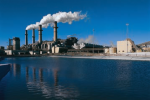
How Do We Use Freshwater Resources?
WE USE LARGE QUANTITIES OF WATER each day, for a variety of purposes, especially power generation and irrigation of farms. How much water does each of our activities consume, and where does the water come from? What Are the Main Ways in Which We Use Fresh Water? The U.S. Geological Survey (USGS) studied water use […]

How Do Water Balances Vary Spatially?
A WATER BALANCE DIAGRAM portrays the moisture condition of a place during any interval of time. Since these diagrams show water balance as a function of time, they allow us to better understand and manage our water resources and recognize limitations that water availability places on ecosystems and society. By comparing water-balance diagrams for different […]

How Do We Evaluate Water Balances?
THE CONCEPT OF A WATER BALANCE is critical in understanding our world and concerns a broad range of topics, from evaluating the health of an ecosystem to gauging the sustainability of a city. Just as an accountant monitors the amount and flow of money in financial transactions, water balance is an accounting of the amount […]

What Is the Global Water Budget?
THE HYDROLOGIC CYCLE is key to many physical and biological processes on Earth as water moves in and out of different parts of the system. It also results in the conversion of solar energy to other forms of energy, such as when water that evaporated from the ocean later falls as rain, forms a river, […]

Where Does Water Occur on the Planet?
WATER IS ABUNDANT ON EARTH, occurring in many settings. Most water is in the oceans, but is salty. Most fresh water is in ice and snow or in groundwater below the surface, with a smaller amount in lakes, wetlands, and streams. Water also exists in plants, animals, and soils and as water vapor in the […]

What Causes Water to Rise or Sink?
MOVEMENT WITHIN THE OCEANS arises from other factors in addition to shearing induced by the wind. Such factors include variations in the density of water in response to changes in its temperature and salinity. Changes in temperature and salinity occur from flows of fresh water into and out of the oceans as a result of […]

What Is a Tornado?
A TORNADO IS THE MOST INTENSE type of storm known, expressed as a column of whirling winds racing around a vortex at speeds up to hundreds of kilometers per hour. The May 1999 tornadoes in Oklahoma City, Oklahoma, were estimated to have wind speeds over 500 km/hr. Fortunately, most tornadoes are less than several hundred […]

How Does Water Occur in the Atmosphere?
THE PRESENCE AND ABUNDANCE OF WATER in the atmosphere are a fundamental control of weather and climate, which both have a profound influence on our lives. The molecular structure of water causes it to have special properties that we can observe every day and that are important to life on Earth. In what forms does […]
Living on Million-Year-Old Water
One recent study demonstrated that the Sahara's hidden but increasingly hard-pressed supply of groundwater is actually fossil water that fell as rain more than a million years ago. This source of groundwater fell from the sky when the African continent was farther south, the current Mediterranean Sea was a low-lying desert, and the Sahara was […]
The Ghost of Water
Most of the rugged, sandy terrain of the Sahara drains into expansive internal basins or, in the north, into the ghostly tributaries of the Nile River. A few rivers that arise beyond the limits of the desert drain into it, contributing to its fitful supply of streams and its ancient supply of groundwater. The greatest […]
Canyons and water: a dangerous combo
The lure of a slot canyon – narrow and serene, with walls that ascend far higher than the canyon's width – is hard for a serious hiker to resist Thousands traipse into these flash-flood factories each year unaware of the risk they face. A downpour in one spot can send water pouring into a slot […]
Water, water, everywhere…
Water exists almost everywhere on the Earth. In the oceans it can be thousands of metres deep. But it also occurs in the form of ponds and puddles (which we shall not dwell on too much), seas and lakes, streams and rivers, and ice caps and glaciers, the subject of our next chapter. Water makes […]

Bodies of Water and Landforms
A HUMAN PERSPECTIVE In July 1971, astronaut James Irwin was lifted into space on the Apollo 15 mission. As he circled the earth, he was deeply moved by the beauty of our planet. Later he wrote this: Anyone passing through our solar system would be attracted to the blue planet. They would know that the […]
Surface Water as a Natural Resource
Fresh surface water is a basic natural resource essential to human agricultural and industrial activities. Runoff held in reservoirs behind dams provides water supplies for great urban centers, such as New York City and Los Angeles, as well as irrigation water for agriculture. We can also generate hydroelectric power from surface water where the gradient of a river is steep. […]
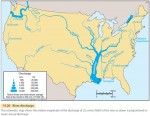
Surface Water
OVERLAND FLOW AND STREAMFLOW Runoff that flows down the land slopes in broadly distributed sheets is called overland flow. This is different from streamflow, in which the water runs along a narrow channel between banks. Overland flow can take several forms. Where the soil or rock surface is smooth, the flow may be a continuous thin film, called sheet flow. […]
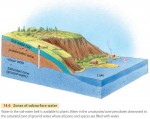
Ground Water
Water from precipitation can flow through the soil-water belt under the force of gravity. We call this flow percolation. Eventually, the percolating water reaches ground water. Ground water is the part of the subsurface water that fully saturates the pore spaces in bedrock, regolith, or soil (Figure 14.6). The top of the saturated zone is marked by the water table. Above […]
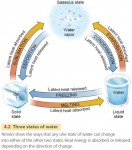
Water in the Environment
In this chapter, we focus on water in the air, both as vapor and as liquid and solid water. Precipitation is the fall of liquid or solid water from the atmosphere that reaches the Earth's land or ocean surface. It forms when moist air is cooled, causing water vapor to form liquid droplets or solid ice particles. If cooling is […]